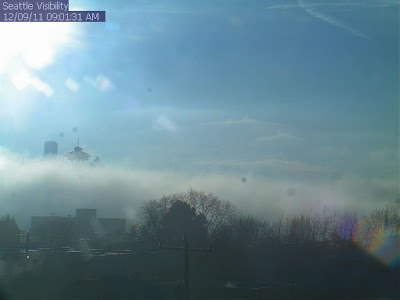We start with the problem. The western side of the state is one of the cloudiest places in the country during the winter and the "bowl" of eastern Washington often fills with low clouds. Plus, we are fairly far north and thus days are short. Fortunately, a little bit of meteorological knowledge and online access to satellite imagery can help you get to sun on many days with a modest drive even when your home is in the murk. And sun is nearly always a short (and inexpensive) plane ride away.
Step 1: Find a good online satellite imagery source
To find sunshine, you need to view satellite imagery--and particularly visible satellite animations. There are a number of good sources of such information, but one I recommend is provided by the National Weather Service: http://www.wrh.noaa.gov/satellite/?wfo=sew
There are many others, including my own department web site. If we are in an unusually sunny situation you will be able to determine that from such imagery. If sunny, don't proceed any farther and GET OUTSIDE ASAP TO ENJOY IT!
Step 2: There are clouds in your area and you want to see if there is
some nearby sun. No problem.
If there is strong southwesterly flow, then check for a cloud-free zone to the northeast of the Olympics, roughly between Port Angeles to Port Townsend, and yes Sequim. Sometimes the clearing stretches to Victoria and the southern San Juans. An example is shown below. You see this...you know where to go! In fact, there is an entire web site dedicated to this cloud free zone (http://www.olympicrainshadow.com/)
But there are plenty of times the entire western side of the Cascades is full of clouds. What do you do?
If the flow is more westerly, then there might be a convergence zone over central Puget Sound. It is pouring and raining over Seattle--depressing! But the convergence zone is narrow...a short car drive north and south will get you into sun? Don't believe me? Check out the satellite picture from yesterday. And with westerly flow there is often sinking flow and clearing skies over the eastern slopes of the Cascades--Cle Elum, Wenatchee, Ellensburg, or Yakima could be in bright sun even if the rest of eastern Washington is in the murk (see same image).
Or during periods when high pressure is overhead and flow is weak, the lowlands of western and eastern Washington are in low clouds, but the mountains are clear (see below). What do you do? Head up! Go for a hike or do some skiing. Or just drive up there with some suntan lotion. Here is an example.
Step 3: The Northwest is completely cloud covered from a major storm. And you want warm temperatures and sunny skies. Where do you go if you can't afford to fly to Hawaii or Cancun? No problem. Head to the desert southwest of the U.S. Take a look at the number of hours of sun in December in the graphics below (red is most, dark grey is least). The U.S. southwest is amazingly sunny mid-winter. The worst place (us) and best place (SW) are only about 1000 miles apart! Palm Springs, Tucson, etc. are very safe bets for mid-winter sun...and you can find relatively inexpensive fares (order of $200 RT).
So the bottom line: using a little meteorological knowledge can go a long away to avoiding Northwest winter blues from lack of sunshine.

























































